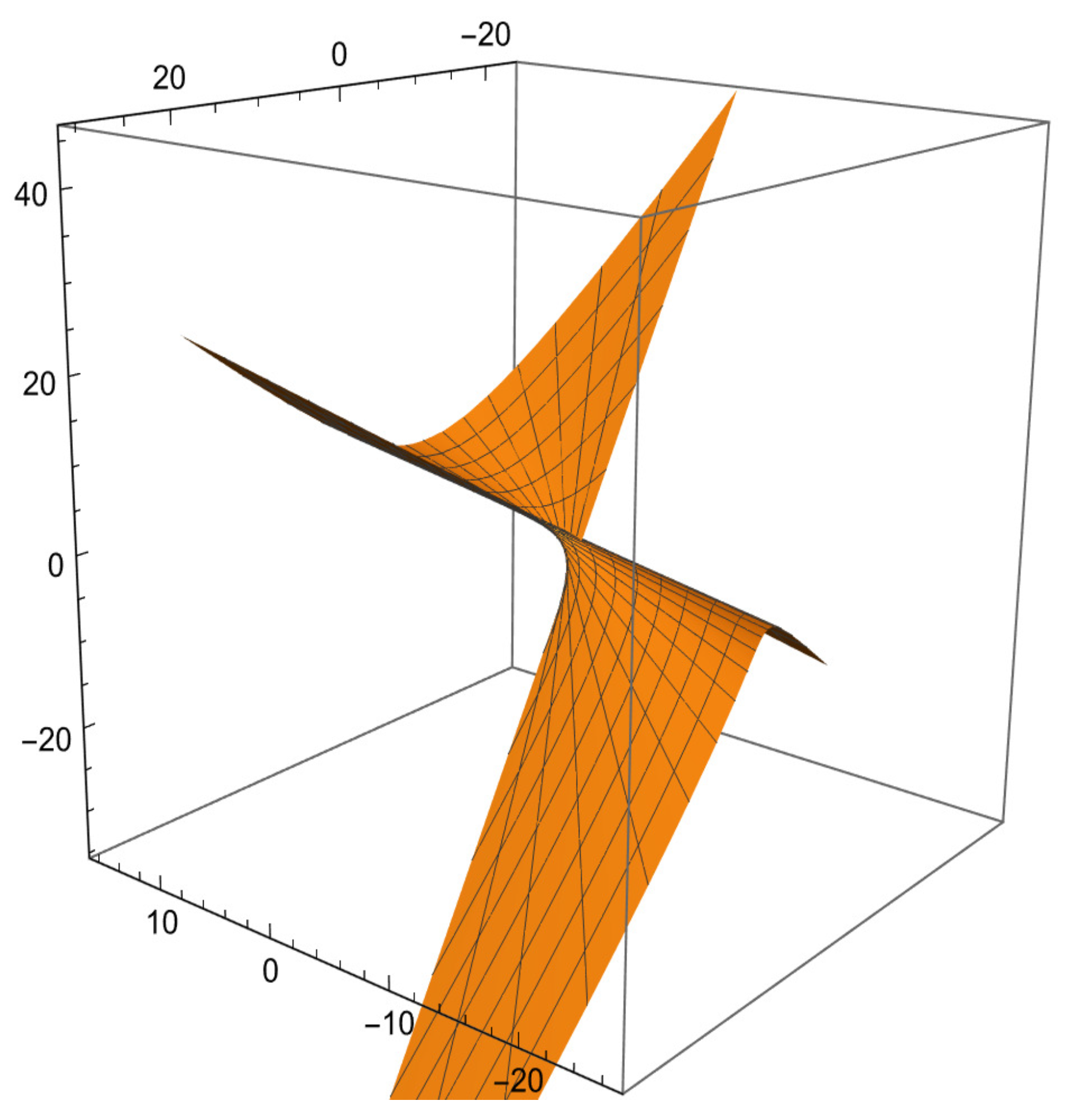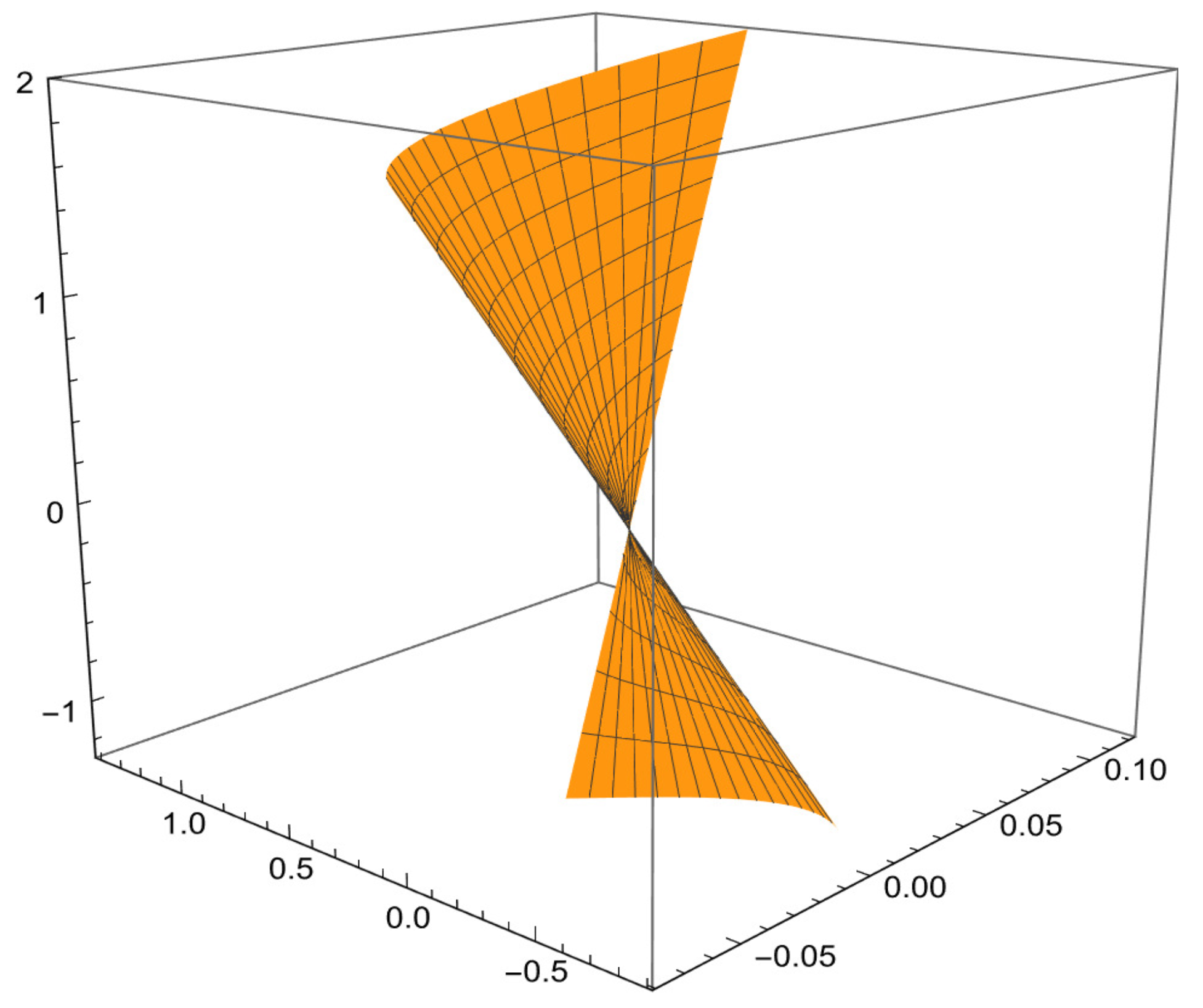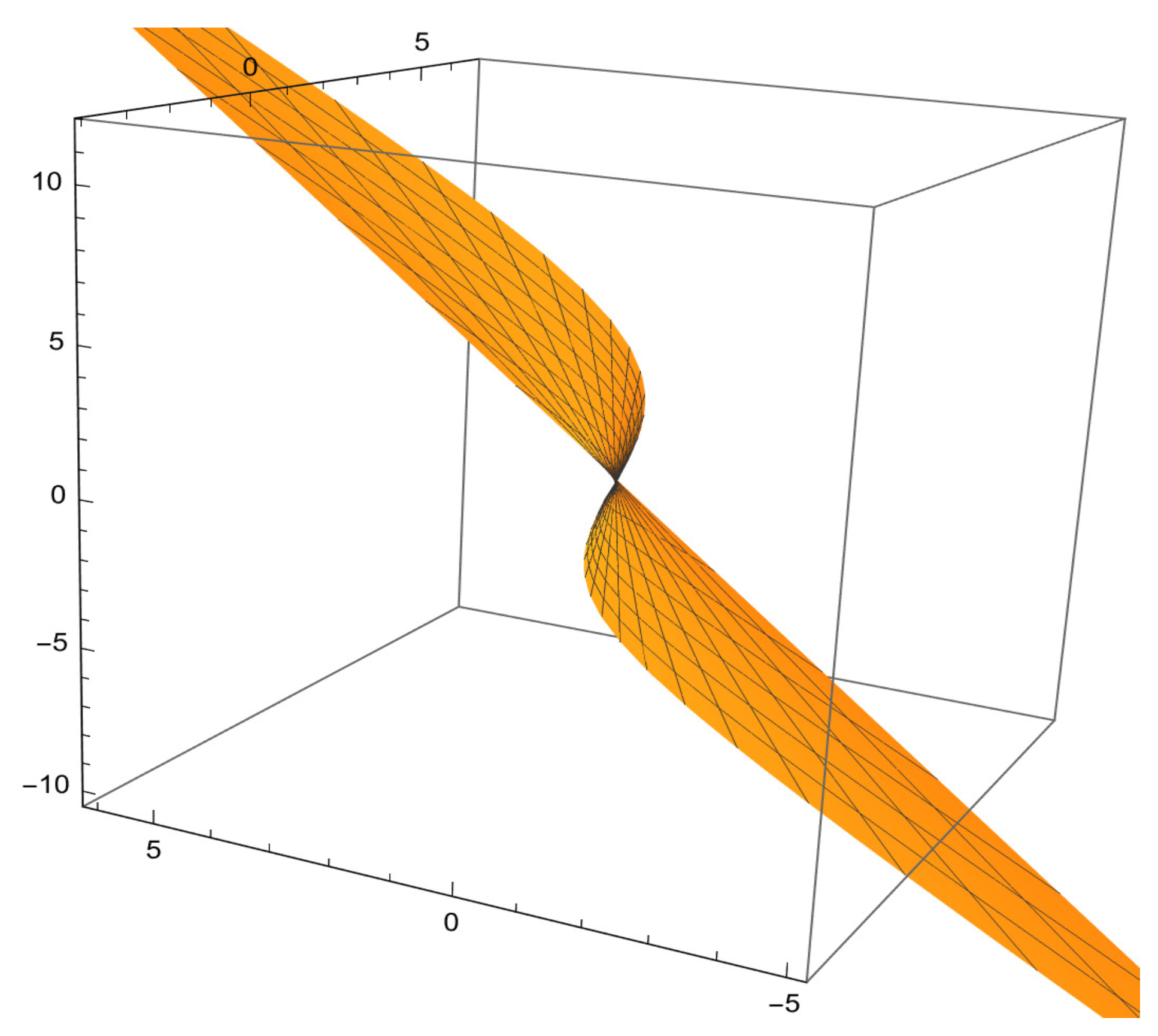Ruled Surfaces and Their Geometric Invariants via the Orthogonal Modified Frame in Minkowski 3-Space
Abstract
1. Introduction
2. Preliminaries
3. Characteristics of Ruled Surfaces via Orthogonal Modified Frame
- 1.
- The surface is developable if and only if .
- 2.
- The surface is minimal if and only if .
- 1.
- Developable if only and only if .
- 2.
- Minimal if only and only if .
- 1.
- Developable if only and only if .
- 2.
- An -linear Weingarten surface if only and only if is a W-curve.
- 1.
- A minimal surface.
- 2.
- Developable if only and only if .
- 3.
- An -linear Weingarten surface if only and only if is a W-curve.
4. Evolutionary Characteristics of Spectacular Ruled Surfaces via Orthogonal Modified Frame
4.1. T-Ruled Surface via Orthogonal Modified Frame
- 1.
- A developable surface.
- 2.
- Minimal if only and only if .
- 3.
- An -linear Weingarten surface if only and only if is a helix.
4.2. N-Ruled Surface via Orthogonal Modified Frame
- 1.
- A developable surface iff .
- 2.
- Minimal if only and only if
4.3. B-Ruled Surface via Orthogonal Modified Frame
- 1.
- A developable surface iff .
- 2.
- Minimal if only and only if .
5. Conclusions
Author Contributions
Funding
Data Availability Statement
Conflicts of Interest
References
- Savić, A.; Eren, K. Soley Ersoy and Vladimir Baltić, Alternative view of inextensible flows of curves and ruled surfaces via alternative frame. Mathematics 2024, 12, 2015. [Google Scholar] [CrossRef]
- Do Carmo, M.P. Differential Geometry of Curves and Surfaces: Revised and Updated Second Edition; Courier Dover Publications: Mineola, NY, USA, 2016. [Google Scholar]
- Misner, C.W.; Thorne, K.S.; Wheeler, J.A. Gravitation; Freeman, W. H. and Company: San Francisco, CA, USA, 1973. [Google Scholar]
- Schneider, P.; Ehlers, J.; Falco, E.E. Gravitational Lenses; Springer: Berlin/Heidelberg, Germany, 1992. [Google Scholar]
- Jackson, J.D. Classical Electrodynamics, 3rd ed.; Wiley: Hoboken, NJ, USA, 1998. [Google Scholar]
- Chandrasekhar, S. The Mathematical Theory of Black Holes; Oxford University Press: Oxford, UK, 1983. [Google Scholar]
- Struik, D.J. Lectures on Classical Differential Geometry, 2nd ed.; Dover Publication Inc.: New York, NY, USA, 1961. [Google Scholar]
- Eisenhart, L.P. Riemannian Geometry; Princeton University Press: London, UK, 1926. [Google Scholar]
- Bukcu, B.; Karacan, M.K. On the modified orthogonal frame with curvature and torsion in 3-space. Math. Sci. Appl.-Notes 2016, 4, 184–188. [Google Scholar] [CrossRef]
- Bukcu, B.; Karacan, M.K. Spherical curves with modified orthogonal frame. J. New Results Sci. 2016, 5, 60–68. [Google Scholar]
- Elsayied, H.K.; Altaha, A.A.; Elsharkawy, A. On some special curves according to the modified orthogonal frame in Minkowski 3-space . KASMERA 2021, 49, 2–15. [Google Scholar]
- Solouma, E.; Al-Dayel, I.; Khan, M.A.; Abdelkawy, M. Investigation of Special Type-II Smarandache Ruled Surfaces Due to Rotation Minimizing Darboux Frame in E3. Symmetry 2023, 15, 2207. [Google Scholar] [CrossRef]
- Solouma, E.; Al-Dayel, I.; Khan, M.A.; Lazer, Y.A. Characterization of imbricate-ruled surfaces via rotation-minimizing Darboux frame in Minkowski 3-space . AIMS Math. 2024, 9, 13028–13042. [Google Scholar] [CrossRef]
- Kemal, E.; Kosal, H.H. Evolution of space curves and the special ruled surfaces with modified orthogonal frame. AIMS Math. 2020, 5, 2027–2039. [Google Scholar]
- Lone, M.S.; Es, H.; Karacan, M.K.; Bkc, B. Mannheim curves with modified orthogonal frame in Euclidean 3-space. Turk. J. Math. 2019, 43, 648–663. [Google Scholar] [CrossRef]
- Lone, M.S.; Es, H.; Karacan, M.K.; Bkc, B. On some curves with modified orthogonal frame in Euclidean 3-space. Iran. J. Sci. Technol. A Sci. 2019, 43, 1905–1916. [Google Scholar] [CrossRef]
- Ouarab, S. Smarandache ruled surfaces according to Frenet-Serret frame of a regular curve in E3. Abstr. Appl. Anal. 2021, 2021, 5526536. [Google Scholar] [CrossRef]
- López, R. Differential geometry of curves and surfaces in Lorentz-Minlowski space. Int. Electron. J. Geom. 2014, 7, 44–107. [Google Scholar] [CrossRef]
- O’Neill, B. Semi-Riemannian Geometry with Applications to Relativity; Academic Press: New York, NY, USA, 1983. [Google Scholar]
- Hu, G.; Cao, H.; Wu, J.; Wei, G. Construction of developable surfaces using generalized C-Bézier bases with shape parameters. Comput. Appl. Math. 2020, 39, 157. [Google Scholar] [CrossRef]
- Lam, W.Y. Minimal surfaces from infinitesimal deformations of circle packings. Adv. Math. 2020, 362, 106–139. [Google Scholar] [CrossRef]







Disclaimer/Publisher’s Note: The statements, opinions and data contained in all publications are solely those of the individual author(s) and contributor(s) and not of MDPI and/or the editor(s). MDPI and/or the editor(s) disclaim responsibility for any injury to people or property resulting from any ideas, methods, instructions or products referred to in the content. |
© 2025 by the authors. Licensee MDPI, Basel, Switzerland. This article is an open access article distributed under the terms and conditions of the Creative Commons Attribution (CC BY) license (https://creativecommons.org/licenses/by/4.0/).
Share and Cite
Solouma, E.; Al-Dayel, I.; Abdelkawy, M.A. Ruled Surfaces and Their Geometric Invariants via the Orthogonal Modified Frame in Minkowski 3-Space. Mathematics 2025, 13, 940. https://doi.org/10.3390/math13060940
Solouma E, Al-Dayel I, Abdelkawy MA. Ruled Surfaces and Their Geometric Invariants via the Orthogonal Modified Frame in Minkowski 3-Space. Mathematics. 2025; 13(6):940. https://doi.org/10.3390/math13060940
Chicago/Turabian StyleSolouma, Emad, Ibrahim Al-Dayel, and Mohamed A. Abdelkawy. 2025. "Ruled Surfaces and Their Geometric Invariants via the Orthogonal Modified Frame in Minkowski 3-Space" Mathematics 13, no. 6: 940. https://doi.org/10.3390/math13060940
APA StyleSolouma, E., Al-Dayel, I., & Abdelkawy, M. A. (2025). Ruled Surfaces and Their Geometric Invariants via the Orthogonal Modified Frame in Minkowski 3-Space. Mathematics, 13(6), 940. https://doi.org/10.3390/math13060940





